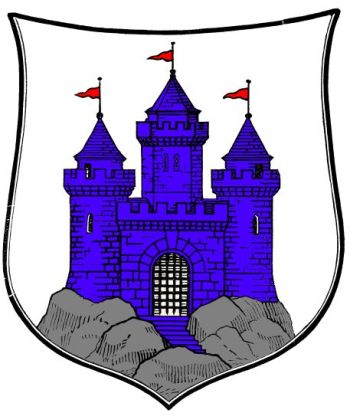Calton (Edinburgh): Difference between revisions
Knorrepoes (talk | contribs) m (Text replacement - "Literature :" to "'''Literature''':") |
Knorrepoes (talk | contribs) m (Text replacement - "Incorporated into :" to "Incorporated into:") Tags: Mobile edit Mobile web edit |
||
| Line 3: | Line 3: | ||
'''CALTON''' | '''CALTON''' | ||
Incorporated into : 1856 [[Edinburgh]] | Incorporated into: 1856 [[Edinburgh]] | ||
[[File:Caltone.jpg|center|350 px|Arms (crest) of Calton]] | [[File:Caltone.jpg|center|350 px|Arms (crest) of Calton]] | ||
Revision as of 09:58, 28 January 2024
| Heraldry of the World |
| British heraldry portal Civic heraldry of the United Kingdom |
|
CALTON
Incorporated into: 1856 Edinburgh
Official blazon
Argent, on a rock proper, a castle triple-towered and embattled azure, topped with three Janes gules, windows and portcullis closed sable.
The arms on the official staff are accompanied by a crest: a dove, argent, with a snake, proper, linked aboUt its legs-and by a motto, PRUDENTIA FRAUDIS NESCIA.
Origin/meaning
The arms were never officially registered.
In 1631 the then Lord Balmerino granted a charter to the trades of Calton constituting them a society or corporation; and in 1669 a Royal charter was obtained from Charles II. erecting the district into a burgh of barony. In 1725 the Town Council of Edinburgh, having purchased the superiority from Lord Balmerino, obtained another charter from George I. By the Municipality Extension Act of 1856 the burgh was absorbed in Edinburgh.
The arms are those of Edinburgh, the castle being Edinburgh Castle, the only difference between them and those of the city of Edinburgh being in the tinctures. The crest and motto are those of Lord Balmerino.
Contact and Support
Partners:
Your logo here ?
Contact us
© since 1995, Heraldry of the World, Ralf Hartemink 
Index of the site
Literature: Bute et al, 1903












